Northrop Grumman EA-6B Prowler Videos
|
Loading...
|
|
Northrop Grumman EA-6B Prowler
EA-6B Prowler
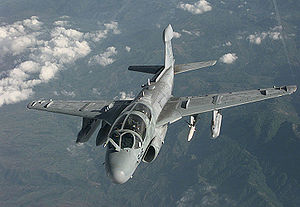
Picture - A U.S. Navy EA-6B Prowler
Role: Electronic Warfare
Manufacturer: Grumman
Northrop Grumman
First flight: 25 May 1968
Introduced: July 1971
Status: Active
Primary users: U.S. Navy
U.S. Marine Corps
Number built: 170
Unit cost: $52 million
Developed from: Grumman A-6 Intruder
The Northrop Grumman EA-6B Prowler is a twin-engine, mid-wing electronic warfare aircraft manufactured by Grumman (now Northrop Grumman) as a modification of the basic A-6 Intruder airframe. The EA-6B has been in service with the U.S. Armed Forces from 1971 through the present. The EA-6B has carried out numerous missions for jamming enemy radar systems, and in gathering radio intelligence on those and other enemy air defense systems. In addition, the EA-6B is capable of carrying and firing anti-radiation missiles (ARM), such as the Shrike missile and the HARM missile. The aircrew of the EA-6B consists of one pilot and three Electronic Countermeasures Officers.
From the 1998 retirement of the U.S. Air Force EF-111 Raven electronic warfare aircraft, the EA-6B was the only dedicated electronic warfare plane available for missions by the U.S. Navy, the U.S. Marine Corps, and the U.S. Air Force until the fielding of the Navy's EA-18G Growler in 2009.
Development
The EA-6A "Electric Intruder" was developed for the U.S. Marine Corps during the 1960s to replace its EF-10B Skyknights. The EA-6A was a direct conversion of the standard A-6 Intruder airframe, with two seats, equipped with electronic warfare (EW) equipment. The EA-6A was used by three Marine Corps squadrons during the War in Vietnam. A total of 27 EA-6As were produced, with 15 of these being newly-manufactured ones. Most of these EA-6As were retired from service in the 1970s with the last few being retired in the 1980s. The EA-6A was essentially an interim warplane until the more-advanced EA-6B could be designed and built.
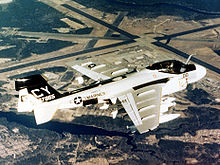
Picture - A Marine EA-6A Intruder over Cherry Point, 1978. The two-seat EA-6A would be followed by the more advanced four-seat EA-6B Prowler.
The much more advanced and substantially redesigned EA-6B was developed beginning in 1966 as a replacement for EKA-3B Skywarriors for the U.S. Navy. The forward fuselage was lengthened to create a rear area for a larger four-seat cockpit, and an antenna fairing was added to the tip of its vertical stabilizer. The Prowler first flew on 25 May 1968, and it entered service on aircraft carriers in July 1971. Three prototype EA-6Bs were converted from A-6As, and five EA-6Bs were developmental airplanes. A total of 170 EA-6B production aircraft were manufactured from 1966 through 1991.
The EA-6B Prowler is powered by two turbojet engines, and it is capable of high subsonic speeds. Due to its extensive electronic warfare operations, and the aircraft's age (produced until 1991), the EA-6B is a high-maintenance aircraft, and it also has undergone more frequent equipment upgrades than any other aircraft in the Navy or Marine Corps. Although designed as an electronic warfare and command-and-control aircraft for air strike missions, the EA-6B is also capable of attacking some surface targets on its own, in particular enemy radar sites and surface-to-air missile launchers. In addition, the EA-6B is capable of gathering electronic signals intelligence.
The EA-6B Prowler has been continually upgraded over the years. The first of which was named "expanded capability" (EXCAP) beginning in 1973. Then came "improved capability" (ICAP) in 1976 and ICAP II in 1980. The ICAP II upgrade provided the EA-6B with the capability of firing Shrike missiles and AGM-88 HARM missiles.
Advanced Capability EA-6B
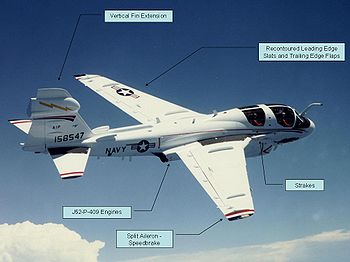
Picture - EA-6B ADVCAP
The Advanced Capability EA-6B Prowler (ADVCAP) was a development program initiated to improve the flying qualities of the EA-6B and to upgrade the avionics and electronic warfare systems. The intention was to modify all EA-6Bs into the ADVCAP configuration, however the program was removed from the Fiscal Year 1995 budget due to financial pressure from competing Department of Defense acquisition programs.
The ADVCAP development program was initiated in the late 1980s and was broken into three distinct phases: Full-Scale Development (FSD), Vehicle Enhancement Program (VEP) and the Avionics Improvement Program (AIP).
FSD served primarily to evaluate the new AN/ALQ-149 Electronic Warfare System. The program utilized a slightly modified EA-6B to house the new system.
The VEP added numerous changes to the aircraft to address deficiencies with the original EA-6B flying qualities, particularly lateral-directional problems that hampered recovery from out-of-control flight. Bureau Number 158542 was used. Changes included:
Leading edge strakes (to improve directional stability)
Fin pod extension (to improve directional stability)
Ailerons (to improve slow speed lateral control)
Re-contoured leading edge slats and trailing edge flaps (to compensate for an increase in gross weight)
Two additional wing stations on the outer wing panel (for jamming pods only)
New J52-P-409 engines (increased thrust by 2,000 lbf (8.9 kN) per engine)
New digital Standard Automatic Flight Control System (SAFCS)
The added modifications increased the aircraft gross weight approximately 2,000 pound (900 kg) and shifted the center of gravity 3% MAC aft of the baseline EA-6B. When operating at sustained high angles of attack, fuel migration would cause additional shifts in CG with the result that the aircraft had slightly negative longitudinal static stability. Results of flight tests of the new configuration showed greatly improved flying qualities and the rearward shift of the CG had minimal impact.
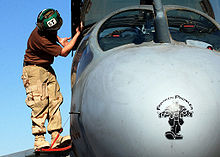
Picture - "FrankenProwler" during a preflight inspection at Al Asad Air Base, Iraq.
The AIP prototype (bureau number 158547) represented the final ADVCAP configuration, incorporating all of the FSD and VEP modifications plus a completely new avionics suite which added multi-function displays to all crew positions, a head-up display for the pilot, and dual Global Positioning/Inertial navigation systems. The initial joint test phase between the contractor and the US Navy test pilots completed successfully with few deficiencies.
After the program was canceled, the three experimental Prowlers, BuNo 156482, 158542 and 158547, were mothballed until 1999. During the next several years, the three aircraft were dismantled and reassembled creating a single aircraft, b/n 158542, which the Navy dubbed "FrankenProwler". It was returned to active service 23 March 2005.
Improved Capability (ICAP)
Northrop Grumman received contracts from the U.S. Navy to deliver new electronic countermeasures gear to Prowler squadrons; the heart of each ICAP III set consists of the ALQ-218 receiver and new software that provides more precise selective-reactive radar jamming and deception and threat location. The ICAP III sets also are equipped with the Multifunction Information Distribution System (MIDS), which includes the Link 16 data link system. Northrop has delivered two lots and will be delivering two more beginning in 2010. The majority of EA-6B Prowlers in service today are the ICAP II version, carrying the ALQ-99 Tactical Jamming System.
Design
Designed for carrier-borne and advanced base operations, the EA-6B is a fully integrated electronic warfare system combining long-range, all-weather capabilities with advanced electronic countermeasures. A forward equipment bay and pod-shaped fairing on the vertical fin house the additional avionics equipment. It is now the primary electronic warfare aircraft for the U.S Navy, U.S. Marine Corps, and U.S. Air Force. The primary mission of the EA-6B is to support ground-attack strikes by disrupting enemy electromagnetic activity. As a secondary mission is can also gather tactical electronic intelligence within a combat zone, and another secondary mission is attacking enemy radar sites with anti-radiation missiles.
The Prowler has a crew of four, a pilot and three Electronic Countermeasures Officers (known as ECMOs). Powered by two non-afterburning Pratt & Whitney J52-P-408 turbojet engines, it is capable of speeds of up to 590 miles per hour (950 km/h) with a range of 1,140 miles (1,840 km).
Design particulars include the refueling probe being asymmetrical, appearing bent to the right. It contains an antenna near its root. The canopy has a shading of gold to protect the crew against the radio emissions that the electronic warfare equipment produces.
Operational history
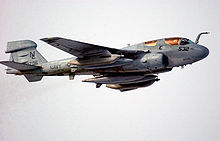
Picture - EA-6B Prowler takes off from Eielson AFB. Note the tint of the gold embedded in the canopy. The gold provides protection from electromagnetic interference and prevents some EM emissions
Since the retirement of the EF-111 Raven in 1995, the EA-6B is the only dedicated aerial radar jammer aircraft of the U.S. Armed Forces. The EA-6B has been flown in practically every American combat operation since 1995, and is frequently flown in support of the U.S. Air Force missions.
About 125 Prowlers remain today, divided between twelve Navy, four Marine, and four joint Navy-Air Force "Expeditionary" squadrons. A JCS staff study recommended that the EF-111 Raven be retired to reduce Type/Model/Series aircraft dedicated to the same mission, which led to an OSD Program Decision Memorandum (PDM) to establish 4 "expeditionary" Prowler squadrons composed of Navy and USAF personnel to meet the needs of the Air Force.
Though once considered being replaced by Common Support Aircraft, the original plan failed to materialize. The EA-6B remains in active service today. In 2009 the Navy EA-6B Prowler community begin transitioning to the EA-18G Growler, a new electronic warfare derivative of the F/A-18F Super Hornet. All but one of the active duty Navy EA-6B squadrons are based at Naval Air Station Whidbey Island, located in the northwest corner of the state of Washington. VAQ-136 is stationed at Naval Air Facility Atsugi, Japan, as part of Carrier Air Wing 5, the forward deployed naval forces (FDNF) air wing that embarks aboard the Japan-based USS George Washington (CVN-73). VAQ-209, the Navy Reserve's sole remaining EA-6B squadron, is stationed at Naval Air Facility Washington, Maryland. All Marine Corps EA-6B squadrons are located at Marine Corps Air Station Cherry Point, North Carolina.
Operations in Afghanistan and Iraq
According to news reports, the Prowler has been used in anti-improvised explosive device operations in the current conflict in Afghanistan for several years by jamming remote detonation devices such as garage door openers or cellular telephones. Two Prowler squadrons are also based in Iraq, working with the same mission.
Operators
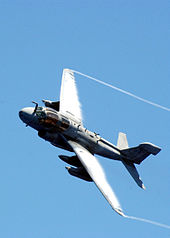
Picture - An EA-6B Prowler from VAQ-138 carrying two wing mounted jamming pods.
The EA-6B Prowler is operated by the U.S. Armed Forces, and has squadrons in both the U.S. Marine Corps and Navy.
USMC squadrons
VMAQ squadrons operate the EA-6B Prowler. Each of the four squadrons operates five aircraft and are land-based, although they are capable of operating aboard U.S. Navy aircraft carriers and have done so in the past.
The USMC is investigating an electronic attack role for the F-35 Lightning II to replace their Prowlers.
USN squadrons
A typical Tactical Electronic Warfare Squadron consists of four EA-6B Prowlers. Navy Electronic Attack squadrons carry the letters VAQ (V-fixed wing, A-attack, Q-electronic). Most VAQ squadrons are carrier based, however a number are "expeditionary", deploying to overseas land bases.
Notable incidents
While no Prowler has ever been lost in combat, over forty were destroyed in various accidents as of 2007.
On 26 May 1981, a USMC EA-6B crashed onto the flight deck of the USS Nimitz (CVN-68) and caused a fire, killing 14 crew men and injuring 45 others.
A USMC EA-6B Prowler, BuNo 163045, from VMAQ-2 caused the Cavalese cable-car disaster on 3 February 1998, accidentally cutting the cables of a ski-lift in Italy during a low level flight in mountainous terrain, killing 20 civilians.
In 1998, a memorial at Naval Air Station Whidbey Island was dedicated to 44 crew members lost in EA-6B aircraft accidents. Later that year, on 10 November 1998, that total increased to 48 when four crew members were killed when a USN EA-6B collided with an S-3 Viking during night landing qualifications on USS Enterprise (CVN-65). Five more aircraft have been lost since 1998, but none resulted in fatalities.
Specifications (EA-6B)
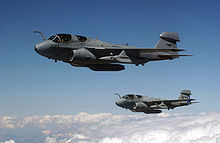
Picture - Two EA-6B Prowlers over Turkey flying in support of Operation Northern Watch, 2002.
Data from US Navy Fact File, US Navy history page
General characteristics
Crew: four (one pilot, three electronic countermeasures officers)
Length: 59 ft 10 in (17.7 m)
Wingspan: 53 ft (15.9 m)
Height: 16 ft 8 in (4.9 m)
Wing area: 528.9 ft² (49.1 m²)
Empty weight: 31,160 lb (15,130 kg)
Max takeoff weight: 61,500 lb (27,900 kg)
Powerplant: 2x— Pratt & Whitney J52-P408A turbojet, 10,400 lbf (46 kN) each
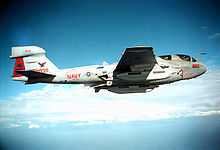
Picture - An EA-6B patrols the skies over Bosnia and Herzegovina, 1995.
Performance
Maximum speed: 566 knots (651 mph, 1,050 km/h)
Cruise speed: 418 kt (481 mph, 774 km/h)
Range: 2,022 mi (tanks kept) / 2,400 mi (tanks dropped) (3,254 km / 3,861 km)
Service ceiling: 37,600 ft (11,500 m)
Rate of climb: 12,900 ft/min (65 m/s)
Wing loading: 116 lb/ft² (560 kg/m²)
Thrust/weight: 0.34
Armament
Up to 4 AGM-88 HARM antiradar missiles
Up to 5 ALQ-99 Tactical Jamming System (TJS) external pods
Up to 5 300 gallon external drop tanks
Avionics
ALQ-99 on board receiver (OBS), ALQ-99 pod mounted jamming system (TJS)
USQ-113 communications jamming system
Related development
A-6 Intruder
Comparable aircraft
EF-111A Raven
EA-18 Growler
Bibliography
Donald, David ed. "Northrop Grumman EA-6B Prowler", Warplanes of the Fleet. AIRtime, 2004. ISBN 1-880588-81-1.
Miska, Kurt H. "Grumman A-6A/E Intruder; EA-6A; EA6B Prowler (Aircraft in Profile number 252)". Aircraft in Profile, Volume 14. Windsor, Berkshire, UK: Profile Publications Ltd., 1974, p. 137-160. ISBN 0-85383-023-1.
Northrop Grumman EA-6B Prowler Pictures and Northrop Grumman EA-6B Prowler for Sale.
Living Warbirds: The best warbirds DVD series.
Source: WikiPedia